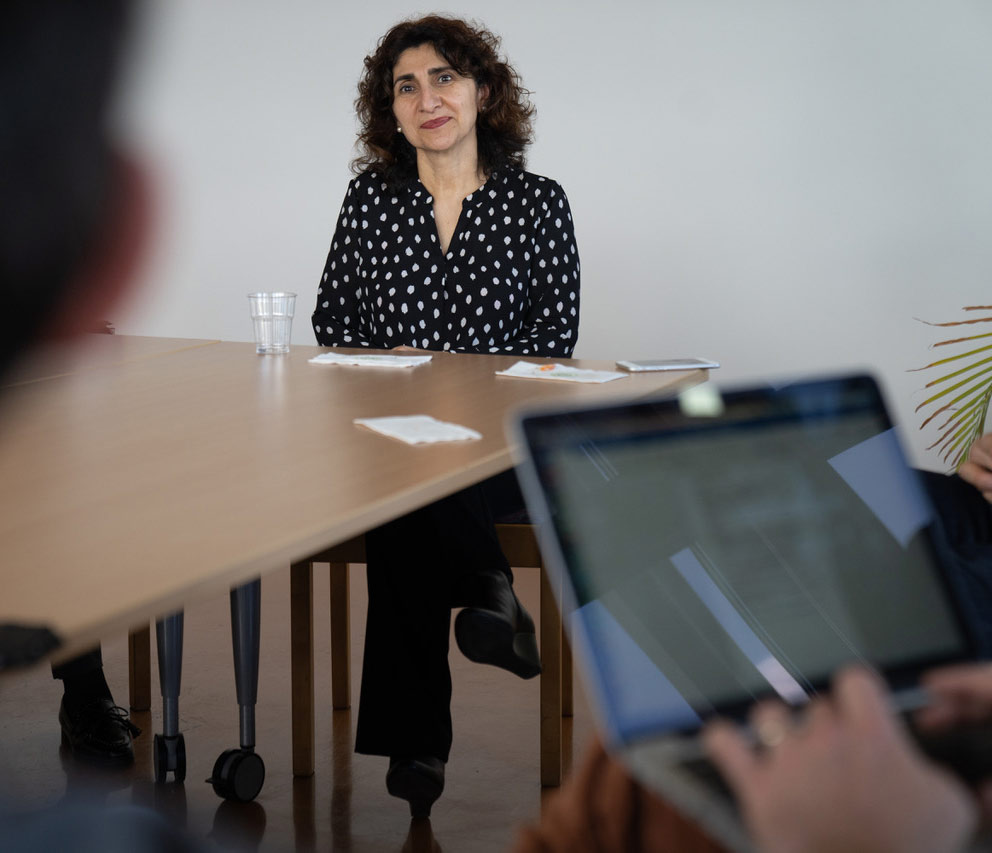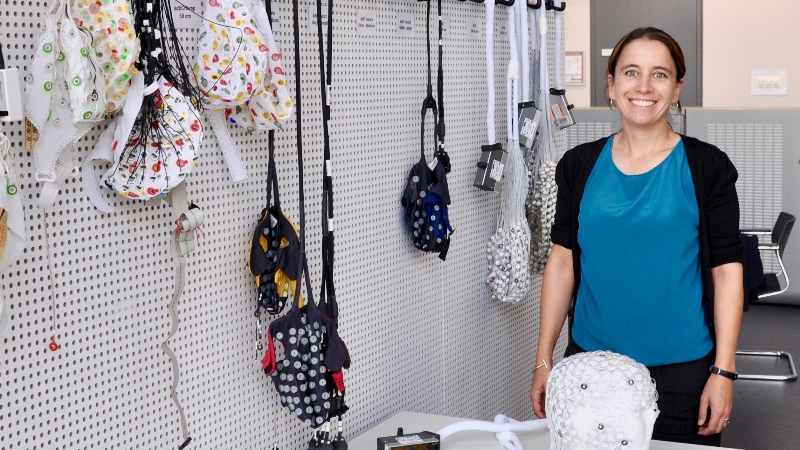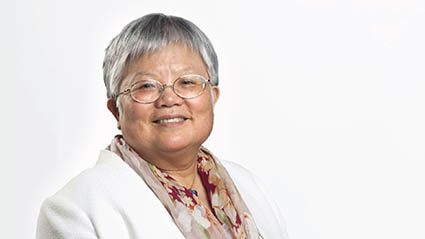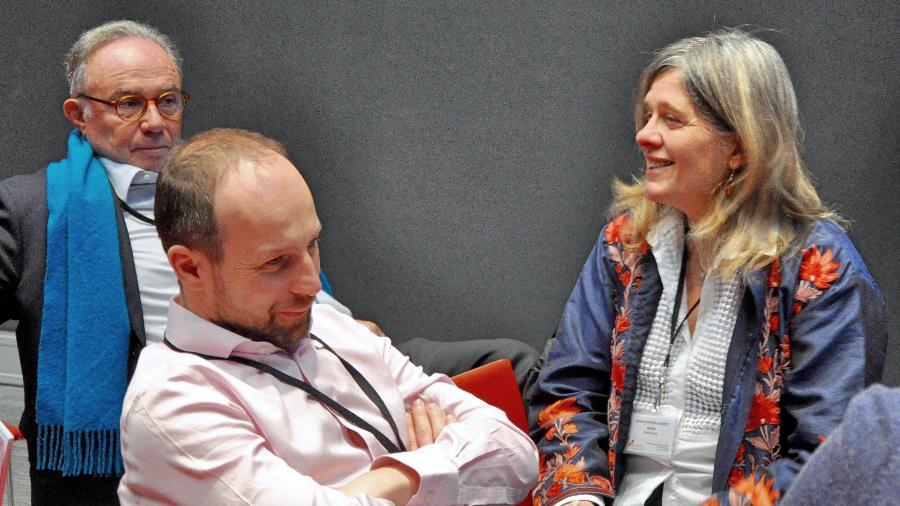EMPOWERMENT
EMPOWERMENT
Three questions for female and male researchers, to get rid of gender bias and fight for emancipation.

Bita Moghaddam is a full professor at Oregon Health and Science University where she holds the Chair of the Department of Behavioral Neuroscience. In the past 26 years, she focused her research on the modeling aspects of psychiatric disorders. Last March, she participated in the Synapsy-LWiN career lunch with students of the Department of Basic Neurosciences of the University of Geneva and took time to answer our questions about gender bias in academia.
What are the most obvious gender inequalities in the world of research?
Inclusion at all levels: academic positions, awards, research resources, papers in high profile journals, and many more things.
What needs to be done to improve the quota of women in research?
I wish I had a good answer but we need to do many things. We need to find out why women are leaving research and find ways of supporting them. We need to identify younger women – and not just a token few – who have the potential to become successful researchers and mentor them better.
What would you say to the next generation of women researchers?
Please do not leave research! We need you! Find mentors – emphasis on plural – to support you. And find ways that are comfortable for you to fight and speak out about inequalities. ●

(Français à la suite)
Tonia Rihs is a senior research and teaching assistant in the Department of Fundamental Neuroscience at the University of Geneva. Tonia followed a training in clinical psychology, and here she reveals what she thinks about gender biases in the world of academia.
What are the most glaring gender inequalities in research?
Our visibility! Men make up 90% of the programs for conferences and seminars, and they’re the main spokespeople in the media. And science-related communication, more often than not, displays a picture of a male researcher – and the same goes for advertising directed at children. But it goes beyond issues of gender, because research is often presented in the media as being the workplace for western men. All of this leads to deep biases that give rise to inequalities.
What needs to be done to improve the quota of women in research?
Well, it’s very difficult. I think that the Swiss National Science Foundation needs to be prepared to give more support, especially during the hardest times, which is the post-doctoral period. And some of the initiatives that are designed to encourage women may act as potential deterrents if they’re seen as being stigmatizing. So, we need to find ways to support women’s careers effectively and which are evidence-based, if that’s possible. In Switzerland, I think the underlying problem is also to do with society. It’s true that it’s very complicated to have a family and be a female researcher at the same time… but why doesn’t the same question arise for men? The way around it is to introduce mentoring programs, highlight examples of female success and empower women to encourage them to pursue their careers.
What would you say to future generations of women researchers?
You have to be robust, find your way and persevere! It’s extremely difficult because the world of academia has an antiquated pyramidal structure that’s based on competition. I’ve noticed that the women who have the most success and find their place have often played sport at a very intense level at some point in their lives. It’s possible that sport gives them a kind of armor that helps them persevere when times are hard or when they get knocked back. I don’t have the answer but it would be an interesting subject to study. Personally, I’ve never been very motivated by sport; I am passionate about music instead.
FRANÇAIS
Maître-Assistante de recherche au Département des neurosciences fondamentales de l’Université de Genève, Tonia Rihs a suivi une formation en psychologie clinique. Elle livre ses ressentis sur les biais de genres dans les milieux académiques.
Quelles sont les inégalités de genre les plus flagrantes dans le monde de la recherche ?
La visibilité ! Les hommes composent à 90 % les programmes de conférences et de séminaires, sont les principaux interlocuteurs des médias et la communication autour des sciences affiche très souvent l’image du chercheur au masculin. C’est également le cas dans la publicité adressée aux enfants. Cela va même au-delà des problématiques de genre, car la recherche est présentée comme étant un secteur réservé à l’Occidental caucasien et blanc de peau. Tout cela engendre des biais profonds qui mènent à des inégalités.
Que faut-il faire pour améliorer le quota de femmes en recherche ?
C’est très difficile. Je pense qu’il faudrait plus de volonté de soutien de la part du Fonds national suisse, surtout pendant la période la plus dure qui est celle du postdoctorat. Il y a aussi un potentiel effet dissuasif de certaines mesures d’encouragement si ces mesures sont perçues comme stigmatisantes. Il faudrait donc trouver des moyens pour soutenir les carrières des femmes de manière effective et « evidence-based » si cela existe. Ensuite, en Suisse, je pense que le fond du problème est aussi sociétal. S’il est vrai qu’il est très compliqué d’avoir une famille et d’être chercheuse à la foi, pourquoi cette question ne se pose pas pour un homme ? Pour pallier à ceci, il faut des programmes de mentorat, mettre en avant des modèles de réussite au féminin et faire de l’empowerment afin d’encourager les femmes à poursuivre leur voie.
Que dire aux futures générations de chercheuses ?
Il faut être solide, tracer sa voie et persévérer ! C’est extrêmement difficile, car le milieu académique suit une structure pyramidale moyenâgeuse basée sur la compétition. J’observe que les femmes qui réussissent le mieux à se faire une place ont souvent fait du sport de manière intense à un moment de leur vie. Peut-être que le sport leur donne une certaine carapace pour persévérer lors des moments difficiles ou des revers ? Je n’ai pas la réponse, mais ça serait un sujet d’étude intéressant. Personnellement, je n’ai jamais été très motivée par le sport, c’est la musique qui me passionne.
 (Français à la suite)
(Français à la suite)
Kim Do is full professor at the Department of Psychiatry of UNIL-CHUV. Below she answers our questions about gender equality in the field of research in psychiatry.
What needs to be done to improve the quota of women in research?
It starts with the education girls are given when they are young. We need to encourage them to freely choose their toys, hobbies or sports without any gender considerations. A young woman who has grown up with the idea that every door is open to her will have the confidence to opt for a career that doesn’t necessarily correlate with a female stereotype. This is all the more important given that, from a neurobiological perspective, childhood and adolescence correspond to the critical period of high synaptic plasticity – a decisive period during the development of the brain.
Furthermore, women must of course have access to the facilities allowing them to pursue their careers while taking on the responsibilities of motherhood. But that’s an issue that concerns every line of work and not just research.
Is it more difficult for women to pursue a career in basic neuroscience than clinical psychiatry?
I don’t think so but it depends, of course, on every woman’s personal motivation. The human component of clinical psychiatry can be very rewarding but also sometimes hard to bear. Research is a long-term process, which requires lots of patience, perseverance, discipline and rationality – as well as creativity and intuition. In my opinion, a woman can feel comfortable and prove herself in both fields.
I’d like to point out that we have designed a curriculum in translational psychiatry, which enables clinicians to dedicate 50% of their working time to research. This partition between clinical work and research allows to train a new generation of innovative, high-level academics, who will make a decisive contribution to improving the treatment of psychiatric diseases – and possibly to preventing them.
What advice would you give to the next generation of researchers?
Keep hold of your self-confidence, persevere and stay committed in spite of the difficulties that will inevitably come up. Team spirit, respect and collaboration between men and women bring progress for everyone, and it’s up to all of us to fight to achieve our goals.
FRANÇAIS
Professeure ordinaire au Département de psychiatrie de l’UNIL-CHUV, Kim Do répond à nos questions sur l’égalité des genres dans le monde de la recherche en psychiatrie.
Que faut-il faire pour améliorer le quota de femme en recherche?
Cela commence par l’éducation que l’on donne aux petites filles. Les encourager à choisir librement et sans considération sexiste leurs jouets, leurs loisirs ou les sports qu’elles souhaitent pratiquer. Une jeune femme qui a grandi avec l’idée que toutes les portes lui sont ouvertes se sentira en confiance pour choisir une voie qui ne correspond pas forcément à un stéréotype féminin. Cela d’autant plus que, d’un point de vue neurobiologique, l’enfance et l’adolescence correspondent à la période critique de haute plasticité synaptique – une période déterminante durant le développement du cerveau.
D’autre part, il convient bien entendu de mettre en place les infrastructures nécessaires pour permettre aux mères de famille de poursuivre leur carrière professionnelle tout en assumant les responsabilités de la maternité – mais il s’agit là d’une question qui concerne tous les domaines d’activités et pas seulement la recherche.
Pour une femme, est-il plus difficile de faire une carrière en neurosciences fondamentales qu’en psychiatrie clinique ?
Je ne pense pas mais cela dépend bien sûr de la motivation de chacune. La composante humaine en psychiatrie clinique peut s’avérer très enrichissante mais parfois lourde à porter. La recherche est un processus de longue haleine, qui exige beaucoup de patience, de persévérance, de rigueur et de rationalité – mais aussi de créativité et d’intuition. Une femme peut à mon avis se sentir à l’aise et faire ses preuves dans les deux domaines.
J’aimerais relever que nous avons créé un cursus en psychiatrie translationnelle, qui permet à des clinicien-ne-s de consacrer 50% de leur temps de travail à la recherche. Ce partage entre clinique et recherche permet de former une relève académique innovante et de haut niveau, qui contribuera de manière déterminante à un meilleur traitement voire à une possible prévention des maladies psychiatriques.
Que conseilleriez-vous à la future génération de chercheuses ?
De garder confiance en elles et de persévérer dans leur engagement malgré les difficultés qui se présentent inévitablement. L’esprit d’équipe, le respect et la collaboration entre hommes et femmes sont porteurs de progrès pour tous et il incombe à chacun-e de savoir se battre pour atteindre ses objectifs.
Ghislaine Dehaene-Lambertz is a French researcher in cognitive psychology, specialist of infant brain development. In this interview Ghislaine tells us all about her difficult position regarding feminism and gives her advice to the next generation of researchers.

What are the most obvious gender inequalities in the world of research?
Ghislaine Dehaene-Lambertz : One of the most irritating problem relates to how authors are listed in articles. When researchers work together, the way the collaboration is perceived varies according to gender. If the researcher is a woman, the assistance she gives is seen as being ‘normal’ and her name won’t be retained in the list of authors. But if it’s a man, the fact that he has been taken away from his research to help means he’s a real contributor and he will be included as one of the authors. I don’t think it’s down to male researchers not wanting to see women featuring in lists of authors but because women’s contribution remains invisible. It’s the well-known stereotype of the empathic woman. Since women are conciliatory by nature, they don’t fight to be included as authors nor higher hierarchical positions. When it comes down to it, women’s CVs have fewer publications on them and their access to academic positions suffers as a result.
Another problem is that women often do not want to take up positions of responsibility. If you take me as an example, I’m sorry but I have absolutely no desire to be director of a centre or department. Putting positions of responsibility to one side, female students searching for a postdoc will first look at what their boyfriends are doing. But they should be looking at what’s important to them, even if it’s often a bit difficult. Personally, I was lucky enough to be able to do the same things as my partner, and at the same time and in the same place as him (Ghislaine is married to the neuroscientist Stanislas Dehaene). It’s generally the women who adapt, and then there are children, which also interrupts your career.
How is your career, which has been so successful, perceived?
GDL : Pretty well, I guess. On the other hand, I’ve always worried a bit about feminist movements. They claim more female in basic science but criticize the fact that I am looking after children for my research, just because it’s the classical role attributed to women. It’s the implicit bias that people have, and I don’t fit neatly into a box.
What would you say to the next generation of women researchers?
GDL : Everything depends on the life of the individual, so it’s difficult to give advice. I would say that you have to grab opportunities when they come along because it is also a question of how you act. In France, male and female researchers as a whole are depressed by the lack of posts, and they’re downtrodden in advance. But this kind of behaviour has always exasperated me because I think that at some point you have to take control of your own destiny. I suggest that the women researchers of tomorrow read the book Indignez-Vous by Stephan Hessel, who fought in the Resistance. When you think of all the things that were achieved during the post-war period when everything was destroyed – well, I think our lives are more comfortable in 2018. You have to try, you have to rebound and – above all – stop saying that it’s all a foregone conclusion! A bit of optimism, please!
